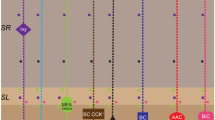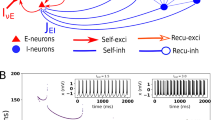Abstract
We study the stability and information encoding capacity of synchronized states in a neuronal network model that represents part of thalamic circuitry. Our model neurons have a Hodgkin-Huxley-type low-threshold calcium channel, display postinhibitory rebound, and are connected via GABAergic inhibitory synapses.
We find that there is a threshold in synaptic strength, τc, below which there are no stable spiking network states. Above threshold the stable spiking state is a cluster state, where different groups of neurons fire consecutively, and each neuron fires with the same cluster each time. Weak noise destabilizes this state, but stronger noise drives the system into a different, self-organized, stochastically synchronized state. Neuronal firing is still organized in clusters, but individual neurons can hop from cluster to cluster. Noise can actually induce and sustain such a state below the threshold of synaptic strength. We do find a qualitative difference in the firing patterns between small (∼10 neurons) and large (∼1000 neurons) networks.
We determine the information content of the spike trains in terms of two separate contributions: the spike-time jitter around cluster firing times, and the hopping from cluster to cluster. We quantify the information loss due to temporally correlated interspike intervals. Recent experiments on the locust olfactory system and striatal neurons suggest that the nervous system may actually use these two channels to encode separate and unique information.
Similar content being viewed by others
References
Bal T, von Krosigk M, McCormick DA (1995) Synaptic mechanisms underlying synchronized oscillations in the ferret lateral geniculate nucleus in vitro. J. Physiol. 483:641-663.
Destexhe A, Bal T, McCormick DA, Sejnowski TJ (1996) Ionic mechanisms underlying synchronized oscillations and propagating waves in a model of ferret thalamic slices. J. Neurophys. 76:2049-2070.
Destexhe A, Contreras D, Sejnowski TJ, Steriade M (1994) A model of spindle rhythmicity in the isolated thalamic reticular nucleus. J. Neurophys. 72:803-818.
Destexhe A, Sejnowski TJ (1997) Synchronized oscillations in thalamic networks: Insights from modeling studies. In Steriade M, Jones EG, McCormick DA, eds. Thalamus. Elsevier. Amsterdam.
Funke K, Nelle E, Li B, Wörgötter F (1996) Corticofugal feedback improves the timing of retino-geniculate signal transmission. Neuroreport 7:2130-2134.
Gluckman BJ, Netoff TI, Neel EJ, Ditto WL, Spano ML, Schiff SJ (1996) Stochastic resonance in a neuronal network from a mammalian brain. Phys. Rev. Lett. 77:4098-4101.
Golomb D, Rinzel J (1994a) Clustering in globally coupled inhibitory neurons. Physica D 72:259-282.
Golomb D, Rinzel J (1994b) Synchronization properties of spindle oscillations in a thalamic reticular nucleus model. J. Neurophys. 72:1109-1126.
Golomb D, Wang XJ, Rinzel J (1996) Propagation of spindle waves in a thalamic slice model. J. Neurophysiol. 75:750-769.
Greenside HS, Helfand E (1981) Numerical integration of stochastic differential equations. Bell Syst. Tech. J. 60:1927.
Huguenard JR, McCormick DA (1992) Simulation of the currents involved in rhythmic oscillations in thalamic relay neurons. J. Neurophys. 68:1373-1383.
Jahnsen H, Llinás R (1984) Ionic basis for the electroresponsiveness and oscillatory properties of the guinea-pig thalamic neurones in vitro. J. Physiol. 349:227-247.
Kopell N, LeMasson G (1994) Rhythmogenesis, amplitude modulation, and multiplexing in a cortical architecture. Proc. Natl. Acad. Sci. 91:10586-10590.
Laurent G, Davidowitz H (1994) Encoding of olfactory information with oscillating neural assemblies. Science 265:1872-1875.
Levin JE, Miller JP (1996) Broeadband neural encoding in the cricket cercal sensory system enhanced by stochastic resonance. Nature 380:165-168.
Longtin A (1997) Autonomous stochastic resonance in bursting neurons. Phys. Rev. E 55:868-876.
Lüthi A, Bal T, McCormick DA (1998) Periodicity of thalamic spindle waves is abolished by ZD7288, a blocker of Ih. J. Neurophysiol. 79:3284-3289.
MacLeod K, Laurent G (1996) Distinct mechanisms for synchronization and temporal patterning of odor-encoding neural assemblies. Science 274:976-979.
MacLeod K, Laurent G (1998) Who reads temporal information contained across synchronized and oscillatory spike trains. Nature 395:693-698.
Mainen ZF, Sejnowski TJ (1995) Reliability of spike timing in neocortical neurons. Science 268:1503-1506.
McCormick DA, Huguenard JR (1992) A model of the electrophysiological properties of thalamocortical relay neurons. J. Neurophys. 68:1384-1400.
Moortgat KT, Keller CH, Bullock TH, Sejnowski TJ (1998) Submicrosecond pacemaker precision is behaviorally modulated: The gymnotiform electromotor pathway. Proc. Natl. Acad. Sci. 95:4684-4689.
Reinagel P, Godwin D, Sherman SM, Koch C (1999) Encoding of visual information by LGN bursts. J. Neurophysiol. 81:2558-2569.
Riehle A, Grun S, Diesmann M, Aertsen A (1997) Spike synchronization and rate modulation differentially involved in motor cortical function. Science 278:1950-1953.
Rieke F, Warland D, de Ruyter van Steveninck RR, Bialek W (1997) Spikes: Exploring the Neural Code. MIT Press, Cambridge.
Rinzel J, Terman D, Wang XJ, Ermentrout B (1998) Propagating activity patterns in large-scale inhibitory neuronal networks. Science 279:1351-1355.
Rodieck RW, Kiang NY-S, Gerstein GL (1962) Some quantitative methods for the study of spontaneous activity of single neurons. Biophys. J. 2:351-368.
Shadlen MN, Newsome WT (1994) Noise, neural codes, and cortical organization. Curr. Opin. Neurobiol. 4:569-579.
Shadlen MN, Newsome WT (1998) The variable discharge of cortical neurons: Implications for connectivity, computation, and information coding. J. Neurosci. 18:3870-3896.
Shannon CE, Weaver W (1949) The Mathematical Theory of Communication. University of Illinois Press, Urbana and Chicago.
Sillito AM, Jones HE, Gerstein GL, West DC (1994) Feature-linked synchronization of thalamic relay cell firing by feedback from the visual cortex. Nature 369:479-482.
Singer W, Gray CM (1995) Visual feature integration and the temporal correlation hypothesis. Annu. Rev. Neurosci. 18:555-586.
Softky WR, Koch C (1993) The highly irregular firing of cortical cells is inconsistent with temporal integration of random EPSPs. J. Neurosci. 13:334-350.
Steriade M, Cormick DA, Sejnowski TJ (1993) Thalamocortical oscillations in the sleeping and aroused brain. Science 262:679-685.
Stern EA, Jeager D, Wilson CJ (1998) Membrane potential of simultaneously recorded striatal spiny neurons in vivo. Nature 394:475-478.
Stopfer M, Bhagavan S, Smith BH, Laurent G (1997) Impaired odor discrimination on desynchronization of odor-encoding neural assemblies. Nature 390:70-74.
Tiesinga PHE, José JV (1999) Spiking statistics in noisy hippocampal interneurons. Neurocomputing 26/27:299-303.
Tiesinga PHE, Rappel W-J, José JV (1998) Synchronization in networks of noisy interneurons. In Bower J, ed. Computational Neuroscience. Plenum Press, New York. pp. 555-559.
Tiesinga PHE, José JV (2000) Robust gamma oscillations in networks of inhibitory hippocampus interneurons. Network 11(1):1-23.
Traub RD, Whittington MA, Colling SB, Buzsaki G, Jeffreys JGR (1996) Analysis of gamma rhythms in the rat hippocampus in vitro and in vivo. J. Physiol. 493:471-484.
von Krosigk M, Bal T, McCormick DA (1993) Cellular mechanisms of a synchronized oscillation in the thalamus. Science 261:361-364.
Wang X-J, Golomb D, Rinzel J (1995) Emergent spindle oscillations and intermittent burst firing in a thalamic model: Specific neuronal mechanisms. Proc. Natl. Acad. Sci. USA 92:5577-5581.
Wang X-J, Rinzel J (1993) Spindle rhythmicity in the reticularis thalami nucleus: synchronization among mutually inhibitory neurons. Neurosci. 53:899-904.
Wang X-J, Buzsáki G (1996) Gamma oscillation by synaptic inhibition in a hippocampal interneuronal network model. J. Neurosci. 16:6402-6413.
Wehr M, Laurent G (1996) Odor-encoding by temporal sequences of firing in neural assemblies. Nature 384:162-165.
Whittington MA, Traub RD, Jeffreys JGR (1995) Synchronized oscillations in interneuron networks driven by metabotropic glutamate receptor activation. Nature 373:612-615.
Wiesenfeld K, Moss F (1995) Stochastic resonance and the benefits of noise: From ice ages to crayfish and SQUIDs. Nature 373:33-36.
Zhan XJ, Cox CL, Rinzel J, Sherman SM (1999) Current clamp and modeling studies of low-threshold calcium spikes in cells of the cat's lateral geniculate nucleus. J. Neurophysiol. 81:2360-2373.
Author information
Authors and Affiliations
Rights and permissions
About this article
Cite this article
Tiesinga, P., José, J.V. Synchronous Clusters in a Noisy Inhibitory Neural Network. J Comput Neurosci 9, 49–65 (2000). https://doi.org/10.1023/A:1008986311274
Issue Date:
DOI: https://doi.org/10.1023/A:1008986311274




